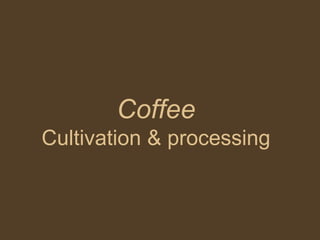
Coffee-Cultivation & Processing.pptx
- 2. Coffea Family Rubiaceae • Coffee is perhaps the most widely used species for a nonalcoholic plant beverages and definately makes an uncompromising part of a common man's daily routine. • The word coffee is derived from the place called Caffa. • Coffee belongs to the genus Coffea which consist of nearby 60 species. • Only three are commercially important out of these species. These species are: 1. Arabian Coffee - (Coffea arabica)- (75-80% of global coffee production) 2. Congo Coffee, Robust Coffee - (Coffea robusta) (20% of global coffee production) • Liberian Coffee -(Coffea liberica) 1% of commercially grown coffee
- 3. History and Origin 3 • The origin of coffee dates back about 500 years. Coffea arabica is nature to the highland of Ethiopia, where the legend of Kaldi, the goatherd is famous regarding origin or coffee trees. • The habit of chewing berries was passed to the Arabian Peninsula in 15th Century by Arab invaders. The Arabs were the first, not only to cultivate coffee but also to begin its trade. • Arab became so fond of coftee drinking that the first public houses were opened in 1470 in Mecca and Medina • It was known in Persia, Egypt, Syria and Turkey by the sixteenth century.
- 4. • Coffee had made its way to Europe and was becoming popular across the continent by the 17th century. • The coffee was brought to New Amsterdam later called New York by the British in the mid-1600. • The Dutch finally succeeded to obtain some seedlings in the latter half of the 17th century. • Their first attempts to plant them in India failed but they were successful with their efforts in Ceylon in 1658 and on the island of Java (now Indonesia) in 1699. • By the end of the 18th century, Coffee had become one of the world's most profitable export crops. • Brazil is the largest producer of coffee, followed by Colombia, Ivory Coast, Mexico, Uganda, Indonesia, Ethiopia, Salvador, Guatemala. 4
- 5. Coffee in India • Coffee is the second most important beverage crop of India next to tea. • Its seeds were brought India from Arabia by Baba Budan in the 17th Century and were raised in the Baba Budan Hills of Karnataka. • Commercial plantations of coffee started in India during the 18th century. • India produces about 2.5 percent of world's coffee. • Coffea arabica and Coffea robusta are the two main varieties of coffee grown in India • India's coffee growing regions can be divided into three categories: 1. Traditional coffee growing regions: Karnataka, Kerala and Tamil Nadu 2. Non-traditional (i.e. relatively new) coffee growing regions : Andhra Pradesh and Orissa on the Eastern Ghats 3. North-Eastern coffee growing regions: Assam, Manipur, Meghalaya, Mizoram, Tripura, Nagaland and Arunachal Pradesh
- 6. Morphology • The coffee tree is an evergreen shrub or tree of 5-10 m height under natural and1.2-1.5 m under cultural condition. • Stem bear spear-shaped green leaves with shiny upper side.The leaves of the robusta trees are much larger than those of the arabica. • A cluster of small snow white star like fragrant flowers occurs in the axil of each leaf. • The fruits known as cherries a small, green, fleshy berries which turn crimson red on maturity. • Coffee beans are ellipsoidal or oval and have two seeds or beans contained in a mucilaginous pulp. Each cherry generally contains two coffee beans; if there is only one it assumes a rounded shape and is known as a peaberry.
- 7. 7 Coffee Trees in Bloom
- 8. 8
- 9. 9
- 10. 10 Soil and climatic conditions for Arabica and Robusta Coffee Climatic Factors Arabica coffee Robusta coffee Soils Rich in organic matter, well-drained and slightly acidic PH ( PH of 6 to 6.50) Same as in arabica Extent of Slope Gentle to moderate Gentle slope to slope fairly level fields Elevation for better growth and yield (m) 1000 to 1500m 500 to 1000m Temperature 15 °C to 25 °C, cool 20°C to 30 °C, hot, RH 70 to 80 % 80 to 90 % Annual rainfall 1600 mm to 2500 mm 1000 to 2000 mm Blossom showers March - April February-March
- 11. Plantation • Propagation of its plant is through seeds, which are sown in December-January and beds are covered with paddy straw to prevent drying. • Germination within 45 days. • Tipping is a regular practice and first tipping is performed when plant is over a 0.5 m and the second one at 1.5 m. • The coffee plant can survive for about 70 years.The first flowers appear during the third year. 11
- 12. Harvesting • The crop will be ready for the first harvest in about 3 - 4 years. • The berries are harvested when these are bright red to deep crimson color, glossy and firm. • The berries are ready for picking 8 to 9 months after flowering and are harvested during the dry season (Oct or February) every year. • The coffee crop is picked by different ways- 1. Handpicking 2. Stripping method 3. Combing Method 4. Mechanical method 12
- 13. Processing • Method of removal of the layer of skin, pulp, mucilage and parchment that envelop the beans. • Coffee beans are processed by three different methods 1. Dry method 2. Semi-drying method 3. Wet method. 13
- 14. 14
- 15. 15
- 16. 16 Drying De-Pulped Coffee Beans
- 17. 17
- 18. 18
- 20. 20
- 22. 22
- 23. 23 Thank you